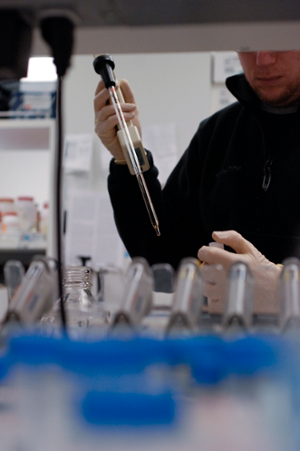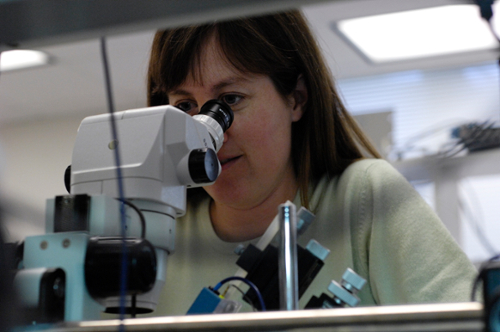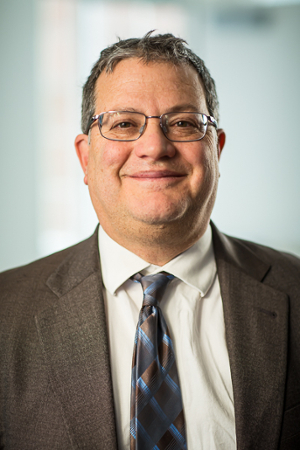Voices of U of U Health
Big Strides in Heart Research
At its heart, Nora Eccles Harrison Cardiovascular Research & Training Institute (CVRTI) is a basic science institute. Our recent discovery of a new molecule that could lead to treatment of chronic heart failure is the sort of high-impact outcome of our fundamental research that drives most of us here.

Heart Therapy
A gene therapy based on this molecule, cardiac BIN1, could drastically improve the options for patients with chronic heart failure. We discovered the cardiac specific form of the general membrane folding protein BIN1, which we now call cBIN1 (“cardiac BIN1”), and found that it organizes cell membrane domains. In heart muscle cells, cBIN1 regulates the intracellular machinery that controls how well a heart pumps and how easily it relaxes in between each beat. Remarkably, cBIN1 as a gene therapy can actually recover failing hearts, including hearts that do not relax well. The discovery of cBIN1 is a part of our research momentum at CVRTI. It took a decade and a half of development. But we're ready to bring it forward now. We discovered a vital protein and what it does in our basic biology. We believe it can go to a human trial in three to five years.
The insight of bringing fundamental basic discoveries forward, such as this one, is very much a part of what we do at the CVRTI, and what I hope we'll be known for in the future. The reason we are focused on heart failure is that it is the major unmet need in human cardiology right now. The problem is also growing and has been called a national unmet epidemic. At the CVRTI, we have taken the resources to translate our discoveries to human therapy.
Scientists and Physicians
Great science requires a lot of collaboration and a lot of cooperation. One of the distinguishing advantages of CVRTI is its faculty structure. We have 14 investigators—half are pure scientists and half are physician scientists. Our multidisciplinary unit has the advantage of covering a broad translational spectrum of science. If asked who best belongs at CVRTI, I’d say that knowledge of a particular technique is of secondary importance. Scientific talent is essential. But to me, the most difficult task for an investigator is knowing how to ask the right questions. The CVRTI is successful because, while we all have our individual skillsets, we are surrounded by scientists who pursue the same topic yet with a very different approach. In this environment, it is much easier for an individual to connect the dots.
At the CVRTI, we are represented by three colleges and five different academic departments. We bring together engineers, biochemists, and clinicians to brainstorm and drive the research. The power in what we do is really in how we collaborate.
Recent Accomplishments

In the last couple of years, we've focused on increasing our funded research, which is driven by the productivity of our current investigators. In the last two years, we've doubled our National Institutes of Health (NIH) funding. NIH is a highly cautious funding body. Sometimes NIH funds research that is only already well on its way to completion. Fortunately, the Nora Eccles Treadwell Foundation (NETF) doesn't have that type of limitation. The NETF wants us to shoot for the stars performing high-risk/high-reward research. Once NETF-funded research is successful and the program established, then we turn to NIH for additional funding.
In the last two years, we have recruited four new investigators and presently house 14 independent labs. With generous support from U of U Health leadership, together with the NETF, we're building a new wing. Currently, we have about 30,000 square feet, and we're putting up another 12,000 square feet of primarily wet bench lab space. We'll break ground around December 2021 or January 2022 and it will be completed for move-in by January 2023.
Prevention Research
Of course, the best form of cardiac practice is preventing the disease from happening. That traditionally has been a primary care issue. But the CVRTI now is really a nucleator of good cardiac research across the translational spectrum, which includes preventative cardiology. Once the new wing is up, we will turn our attention to existing space with the plan of doing a remodel to accommodate “dry space” investigators as well. Since we're in a recruiting phase now with the new wing going up, we also are eager to broaden our research program to investigations further along the translational spectrum
Going Forward
A message that I would like to reinforce locally for the U community is that CVRTI has all of the components to lead the country in the area of muscle biology and heart failure therapeutics. We are the largest freestanding structure in the country focused on basic cardiac biology. We have discovered the therapeutics agents and have the facilities to perform critical pre-clinical research. Given the great need for new therapeutics in heart failure, I am very excited about where we're going. Our recruitments and collaborations are ongoing. And as long as we, as a university community, work and collaborate together, then we're really going to jump to the next level in terms of how the medical center is considered as a leader in this field.
